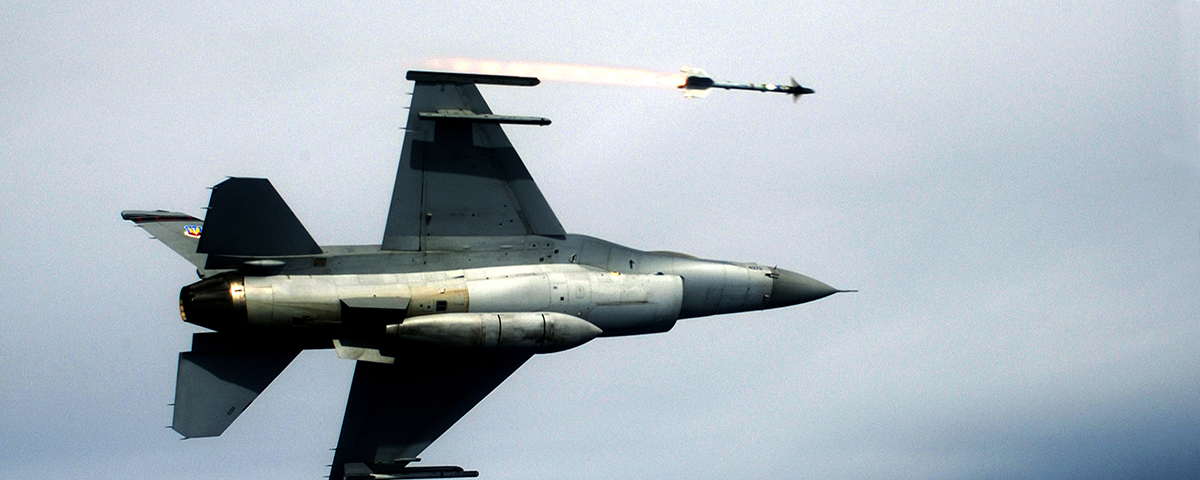The Cold War flared hot on August 23, 1958, when Communist China bombarded Matsu and Quemoy, islands of the Nationalist Republic of China (Taiwan). As Red Chinese and American warships faced off in the For- mosa Strait, Nationalist F-86F Sabres flew against MiGs, including the new MiG-17 “Fresco.” Cruising above and beyond the reach of the Sabres’ machine guns—weapons that had remained basically unchanged since the dawn of fighter aircraft—Fresco pilots enjoyed not only superior numbers but superior technology.
Or did they? In late September the Sabres took on new, American-supplied weaponry—needle-like, 9-foot-long rockets that were barb-tipped and finned, with delicate glass noses instead of steel warheads. The new rocket had no wires, no radio, no way for the pilot to guide it after launch. Yet it was equipped with movable fins, so it could change course. To outside observers the conclusion was inescapable, if unbelievable: The Americans had created a missile that could seek out and destroy the enemy on its own.
From the Allies’ unguided Le Prieur of World War I to World War II’s wire-guided German Ruhrstahl X-4, air-to-air rockets had never proven particularly effective. In the jet age, air combat was supposed to be all about intercepting nuclear-armed strategic bombers at long range. The experts fancied missiles with radar guidance, though this required launch planes to track and “paint” targets with microwaves throughout attack runs.
Meanwhile, at the U.S. Naval Ordnance Test Station at China Lake in California’s Mojave Desert, a few dozen gadgeteers under physicist William B. McLean were toying with lead-sulfide proximity fuzes that were sensitive to the infrared radiation generated by hot objects—like jet engines. China Lake’s directive was R&D, not weapon design, and critics derisively referred to his lab as“McLean’s Hobby Shop.”But that didn’t stop his little team from completely revolutionizing air warfare.
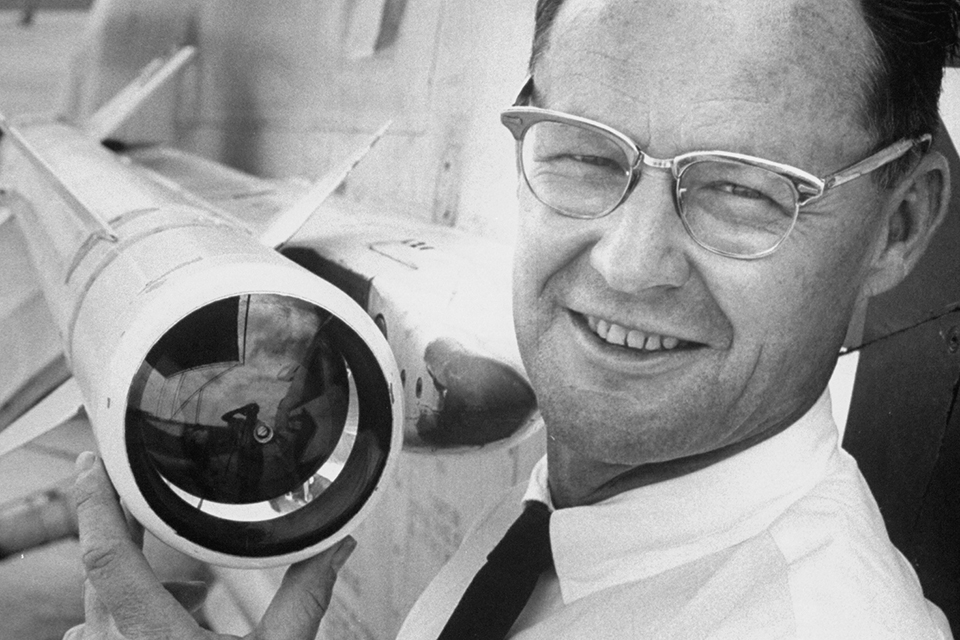
Reasoning that a fuze capable of exploding a warhead near a hot target could also be made to home in on it, McLean sought to put a guidance system entirely onboard a standard 5-inch air-to-ground rocket. With in-house volunteers, miscellaneous funds and spare time—but without official approval—he undertook to develop an intelligent fuze for a heat-seeking air-to-air missile.
It took five years. “I personally spent nearly three years [just] considering possibilities,” McLean later wrote. “It is easy to build something complicated; it’s hard to build it so that it’s simple.”
The final design was indeed simple: a parabolic mirror spinning gyroscopically at 4,200 rpm inside the rocket’s transparent nose. The distance of an infrared blip’s reflection from the axis of spin indicated its angle-off; current from the centrally mounted lead-sulfide detector kept the “eye” on target via electromagnets around its rim and controlled the missile’s canard guide fins.
Future astronaut Wally Schirra, then a hotshot Korea veteran with a MiG-15 kill to his credit, remembered his first visit to McLean’s lab. The China Lake eggheads had a “dome-shaped device, made of glass….a man-made eyeball,”he recalled.“I was a cigarette smoker in those days, and I had one in my hand. As I crossed the room, I noticed that the eyeball was tracking me.”
Since missile roll would interfere with the gyro’s spin, on the fly McLean’s team invented “rollerons”—tailfin-mounted, airstream driven gyro wheels whose spin counteracted the missile’s. The crowning touch, however, was wiring the seeker to aim not where the target was, but where it would be. In dogfights the missile itself would take on enemy aircraft on their own terms: seek them out, run them down and outmaneuver them to make the kill.
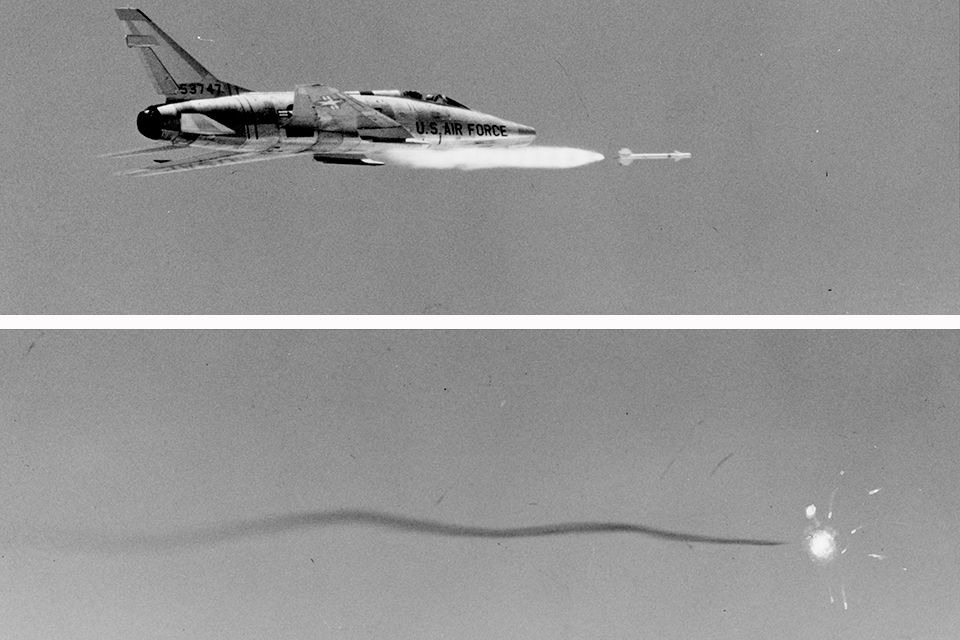
The significance of what the China Lake group accomplished cannot be overstated. More than 60 years ago, back when automobiles were lumbering hunks of Detroit steel, the proto-computer Eniac needed a room full of vacuum tubes merely to calculate ballistic trajectories and the only robots were costumed actors in sci-fi films, what Bill McLean’s China Lake team did—with just 14 tubes and fewer than 24 moving parts, in a package less than 10 feet long, 5 inches across and weighing 160 pounds—was invent fire-and-forget: an autonomous combat robot. They named it Sidewinder, after the Mojave horned rattlesnake, which stalks its prey by their heat signatures in darkness, and crosses the desert sands with a sinuous, winding motion not unlike the missile’s corkscrewing trajectory.
Schirra and other test pilots amused themselves by locking onto not only flying target drones, but also locomotives, tractor-trailers and Greyhound buses near China Lake. Their main complaint, since Sidewinder firing parameters varied with altitude, airspeed and G-load, was having to check a cockpit voltmeter to confirm lock-on. “We’ve got to get something besides the damn gauge,” said test pilot Tom Amlie. “You can’t have a pilot, a fighter pilot in combat, looking [down] at funny little gauges to see if he can fire or not.”
It turned out to be the final piece of the puzzle. Anyone who’s flown a combat flight sim knows the Sidewinder “growl,” indicating missile readiness and target lock. This robot doesn’t just think; it talks.
Just five years later, under the code name “Operation Black Magic,” Americans in F-100 Super Sabres were simulating Red Chinese Frescos, teaching Nationalist pilots “pitch-up” Sidewinder launches against high-altitude targets. The MiG pilots were about to get a nasty surprise.
The final tally depends on which side does the counting, but on a single day, September 24, 1958, the Nationalists’ Sidewinder equipped Sabres shot down at least 10 Frescos. Two weeks later the People’s Republic sued for peace. Command of the air, and thus the battlefield, had been handed back to the West, courtesy of the Sidewinder. Yet one MiG reportedly returned to base with an unexploded missile still embedded in its wing root. Thus despite the project’s top-secret nature, on its first outing the Sidewinder had been outed.
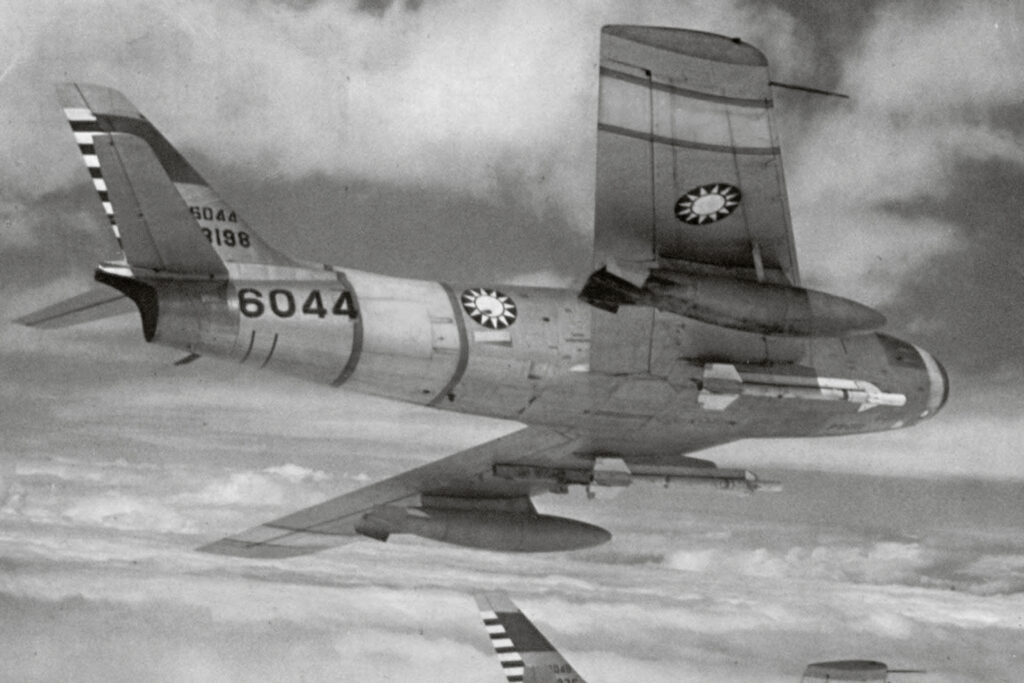
The Soviets, weapons suppliers to half the world, later admitted that the Sidewinder’s near-biological intelligence was a complete revelation to them. They set about reverse-engineering a copy—the K-13, NATO code name AA-2 “Atoll”—and devising tactics to defeat heat-seekers.
The Sidewinder, now designated Air Intercept Missile (AIM) 9, proved decisive once again when Pakistan and India went to war for the second time over Kashmir in 1965. The air battle was unique: primarily American versus British and French warplanes. The Pakistanis were outnumbered 5-to-1, but they had Sidewinders.
On September 6, 1965, Flt. Lt. Aftab Alam Khan of the Pakistan Air Force (PAF) caught four Indian MD.452 Mystère IV fighter-bombers strafing a train. His F-104A Starfighter was a high-level interceptor, not a down-low dogfighter. He blew through the Mystère formation on full burner, at better than Mach 1. The Indians scattered low over the deck, seeking to mask their heat signatures. But before they could escape, Khan used his speed to come back around into a Sidewinder envelope. “I aimed the missile at the nearest aircraft, and heard the loud pitched missile tone,” he recalled. “The sight indicated that I was in range. With all other requisite firing conditions met, I squeezed the trigger, and kept it pressed. I waited, only to note that the missile had not fired. As I looked towards the left missile, I saw a big flash, and the missile leaving the aircraft. The missile had taken, as stipulated in the manual, approx. 8/10ths of a second to fire after the trigger had been pressed, but in combat this seemed like an eternity.” Though India denies it to this day, Pakistani ground control radar confirmed Khan’s missile kill, history’s first by a Mach 2 aircraft. According to Pakistani records, of 36 PAF victories in that war, eight fell to Sidewinders.
At the time, the U.S. was involved in its own Asian conflict. On June 12, 1966, U.S. Navy Commander Harold “Hal” Marr of VF-211 was flying top cover for Douglas A-4 Skyhawks off the carrier Hancock, bombing northwest of Haiphong, when North Vietnamese MiG-17s attacked. Marr’s Vought F-8E Crusader was then the prime Side winder platform. After a four-minute turning battle ranging from 350 to 550 mph and down to 50 feet off the deck, Marr arrived on a Fresco’s tail, triggered a missile and called out “Fox Two!” (Fox Two is the radio call when a heat-seeker is fired; Fox One is for a semi-active radar-guided missile, Fox Three for active radar-guided.) His AIM-9B promptly misguided all the way down to the ground. Marr’s squadron mates headed home, out of ammo and fuel, but he stuck around and launched another Sidewinder—his last. This time, he recalled, “The missile clipped the tail off [the MiG] and it went right into the ground.”
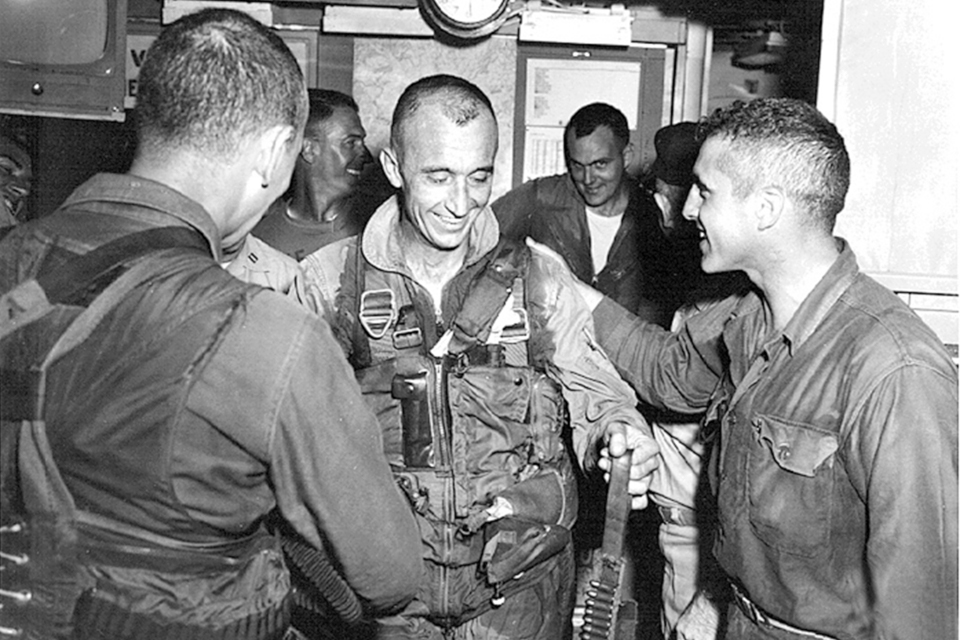
Clearly, the AIM-9 was not infallible. Its range was relatively short—from two miles in high, thin, cold air to less than half a mile in low, warm, dense air. Its infrared vision in wet weather was dodgy at best, and critics claimed its tail-chase launch parameters required the target’s “full cooperation.” Combat pilots learned to evade the heatseekers by leading them into clouds or toward the sun, reflective ice or water, or warm earth. Military aircraft became laden with diversionary flare launchers. A U.S. Air Force study found that from 1965 to ’68, its pilots launched 175 Sidewinders to score just 28 kills, a mere 16 percent success rate. But the AIM-9 was only beginning an extraordinarily long career, characterized by near-constant improvements.
The radar-homing 9C, designed for the Crusader, was phased out along with that plane (the remaining 9Cs were adapted as AGM-122A Sidearm anti-radar missiles). The 9D, featuring a nitrogen-cooled seeker for enhanced heat sensitivity, employed a more powerful rocket motor to triple its range. The 9E introduced Peltier-effect thermoelectric cooling, while the 9H and 9J were the first to feature solid-state electronics. For a while the Air Force and Navy Sidewinders diverged on separate production lines, but all came together on the late-’70s AIM-9L. With an argon-cooled indium-antimonide seeker, the “Nine Lima” was the first model touted as being capable of locking onto the merely warm parts of a target aircraft—like its nose, from dead ahead.
Much was made of this “all-aspect” capability, though in action a head-on shot usually presents itself only once per jet fight—if you’re allowed to take it. In a 1981 Gulf of Sidra incident, two Navy F-14s of the VF-41 “Black Aces” intercepted a pair of Libyan Sukhoi Su-22 “Fitters,” but U.S. rules of engagement required the 9L-equipped Tomcats to hold their fire until fired upon. When one of the Fitters missed with an Atoll from nearly head-on, the Tomcats Sidewindered them both from behind as they fled.
1982 was the year of the AIM-9. When the British Royal Navy mustered a mere 20 Sea Harrier “jump jets” to reclaim the Falklands, Argentina anted up some 100 aircraft, many armed with the AIM-9B and foreign copies, including the French R550 Magic and Israeli Shafrir. The U.S. shipped 100 AIM-9Ls to the Brits, perhaps hoping to achieve a perfect kill ratio with that head-on capability.
On May 1, the opening day of battle, Flight Cmdr. Nigel “Sharkey” Ward, commanding No. 801 Squadron, turned into attacking Mirage III fighters and spotted contrails descending toward him. “I tried to lock one of my [Sidewinders] onto them,” he said, “but the ‘contrails’ turned out to be smoke trails from the missiles they had fired at us!” The Argentine rockets fell into the ocean, but the Mirages escaped.
If the 9L still had trouble acquiring other missiles head-on, against jet pipes it was a magic bullet. On May 24, No. 800 Squadron leader Lt. Cmdr. Andy Auld and wingman Lieutenant Dave Smith were vectored onto the tails of four Argentine Mirage V fighter-bombers. From first launch to last kill, the dogfight lasted less than five seconds. As Ault put it: “We were down at two hundred, at five hundred fifty knots. I fired two missiles in very quick succession against two targets. The missiles guided, and….I was trying for a gun kill on the third, when my wingman fired over my shoulder and his missile scored.”
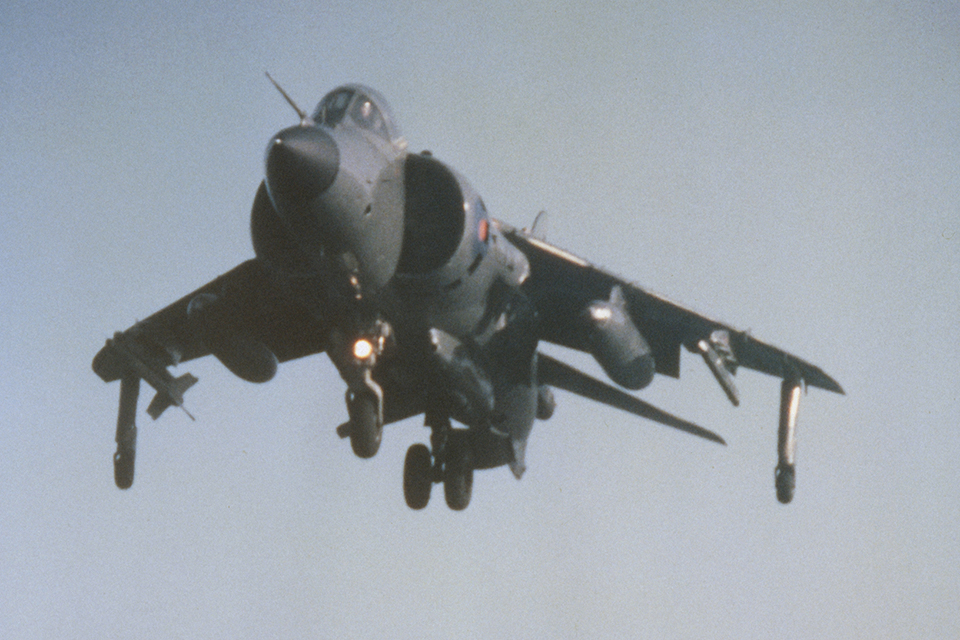
With its double-delta canards pulling 35 Gs in a turn and its laser-triggered proximity fuze setting off a 22-pound annular-blast fragmentation warhead, over the Falklands the 9L achieved an 82 percent kill rate. Argentine A-4 Skyhawk pilot Lieutenant Benito Rotolo reported: “All we could do was try to escape at low level at full throttle….The Sidewinder L is a very, very effective missile and our older models could not hope to equal them.”
Just a few weeks later, over Lebanon’s Bekaa Valley, Israeli F-15s and F-16s used Limas to score 51 of their 55 victories against Syrian MiGs. The 9L proved so deadly, in fact, that the U.S. allowed only its most trusted allies to purchase it. For the rest of the market there was the dumbed-down 9P, of which more than 20,000 were sold. For American fighters there was the AIM-9M, a low-smoke 9L with even better target recognition and anti-countermeasures. Standard equipment during the First Gulf War, the “Mike” version actually scored little, but its reputation was enough to thwart the enemy: Usually the American pilots only got a brief glimpse of Saddam Hussein’s planes at extreme radar range, as they fled over the border to Iran.
Ground-launched, the AIM-9 became the MIM-72 Chaparral. Downsized, it inspired the shoulder-launched FIM-92 Stinger, which ran the Soviets’ Mi.24 Hind helicopters out of Afghanistan. Over the decades the Sidewinder and its heat-seeking kin have been so effective that, just as predators force prey to adapt in the animal kingdom, they’ve influenced aircraft evolution. Witness the F-117 Nighthawk stealth fighter and B-2 Spirit stealth bomber, whose exhaust slots leave wide, thin—and cool—jet wakes.
Some 60 years after it was first introduced, the AIM-9 looks to be one of those weapons, like the AK-47 and B-52, that are more easily improved than replaced. The British AIM-132 ASRAAM couldn’t do it, nor could America’s own AIM-95 Agile. To date, more than 200,000 Sidewinders have been built for 28 countries, making it the most widely used missile in the West—not to mention one of the oldest, cheapest and most successful, with nearly 300 kills worldwide.
The current fifth-generation AIM-9X is to the old 9B what humans are to homo erectus. Paired with a pilot’s helmet-mounted display, it can “look” 90 degrees off-boresight for its target and, with three-dimensional vectored-thrust steering, turn 180 degrees in pursuit. One test pilot at Naval Air Station Fallon, Nev., freshly returned from getting every visual-range first-shot “kill” on Top Gun instructors in F-18s and F-14s, enthused,“If you have [a weapons-sight] helmet and AIM-9X, you are King Kong of the air.”
Against lesser-armed opponents, Navy and Air Force test pilots have achieved 9X kill ratios of better than 50-to-1. In December 2007 at White Sands Missile Range, a modified 9X fired from an F-16 caught and downed a boosting Orion sounding rocket. The latest versions have “lock-on after launch” capability, lending themselves to “cloud shooting,” 360-degree target selection via data link from aircraft other than the launching fighter. No wonder the Sidewinder lives on.
Versions of this versatile, long lived weapon are expected to remain standard equipment well toward the next century. It’s hard to imagine what Sidewinders will be capable of doing by then. They’re already blurring the line between smart weapons and unmanned combat aircraft. When that line is crossed, military aviation will enter an entirely new era.
Don Hollway’s first boyhood short story, “Rocket A-1,” about an autonomous fighting ICBM, has been lost to history. For further reading, he recommends: Sidewinder: Creative Missile Development at China Lake, by Ron Westrum. See more photos and video at donhollway.com/foxtwo.
Originally published in the March 2013 issue of Aviation History. To subscribe, click here.

